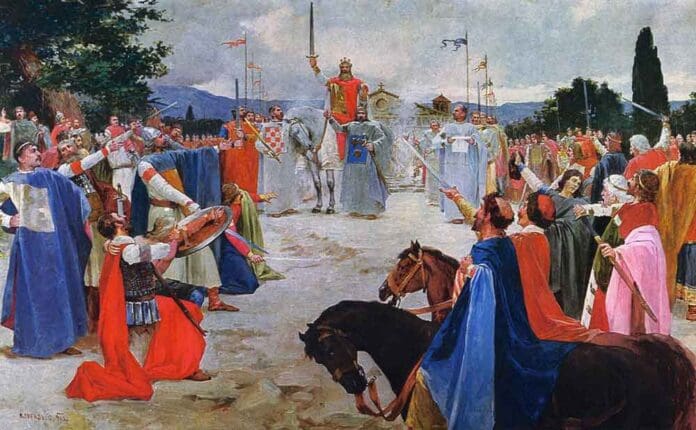by Suzana Fantov
Exactly 1100 years ago, under the leadership of King Tomislav, Croatia rose to join the ranks of European kingdoms, asserting its sovereignty and gaining international recognition.
His coronation marked a turning point in Croatian history – a moment when fragmented principalities were united into a strong and cohesive state, acknowledged by the Church, the Byzantine Empire, and the Frankish Kingdom. Today, more than a millennium later, we proudly commemorate the legacy of Croatia’s first king – a figure whose influence remains deeply embedded in the foundations of the nation’s identity, culture, and statehood.
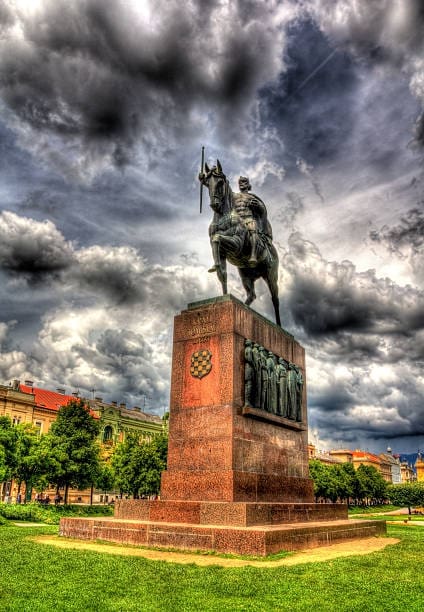
King Tomislav, the first ruler to bear the title of king among the Croats, stands as one of the most significant figures in the country’s early medieval history. The legend of his coronation on the Duvno Field (modern-day Tomislavgrad) in the early 10th century marks a defining chapter in the formation of the Croatian Kingdom – a cornerstone in the creation of the Croatian state as we know it today.
Tomislav, believed to be the son of Duke Muncimir (who ruled from 845 to 862), inherited the title of duke in 910. Upon his ascent, he liberated the region of Pannonian Croatia between the Drava and Sava rivers, later expanding his influence over Bosnia and the region of Hum (modern-day Herzegovina). According to oral tradition, he was crowned with a golden crown on the Duvno Field in 925.
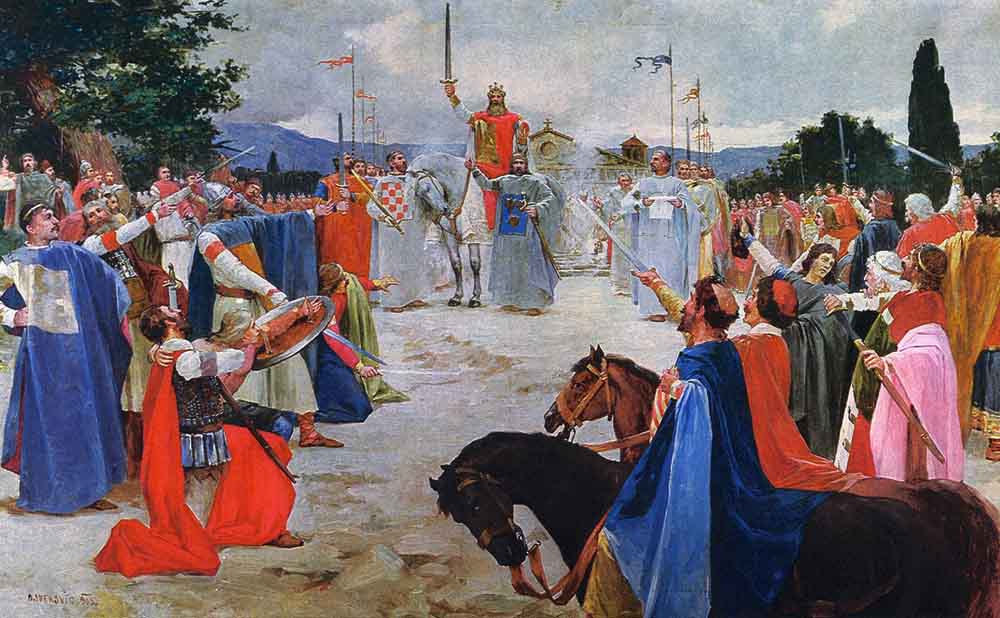
Duvno Field’s strategic location – bridging the coast and the interior – made it an ideal site for such a momentous event. As a historic crossroads dating back to Roman times, its vast expanse allowed for the assembly of nobles, clergy, soldiers, and citizens. The significance of the coronation is further underscored by papal recognition.
Pope John X sent Tomislav a letter acknowledging him as king and blessing his reign, famously referring to him as “Dilecto filio Tamisclao, regi Crouatorum” – “To our beloved son Tomislav, King of the Croats.”
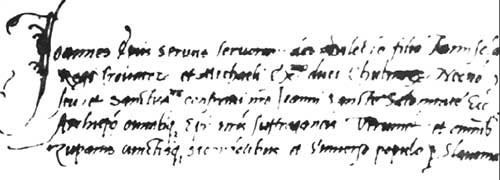
This letter, a critical document in both ecclesiastical and state history, confirms Tomislav’s royal status and highlights the Catholic Church’s support of his rule. Under Tomislav’s leadership, the Croatian Kingdom expanded territorially and politically, uniting the Dalmatian coast with the Pannonian interior and regions of present-day Bosnia and Herzegovina.
Military victories
King Tomislav achieved a crucial military victory over the Hungarians near the Drava River around 925, securing the kingdom’s northern borders. Shortly after, he defeated the army of Bulgarian Tsar Simeon, likely in the region of eastern Bosnia. These victories cemented Croatia’s position as a regional power.
In addition to military success, Tomislav established a formidable naval fleet – one of the most powerful on the Adriatic – securing control over Dalmatian cities and maritime routes, further enhancing Croatia’s economic and strategic standing.
At the First Church Council of Split in 925, attended by Tomislav himself, fifteen key decisions were made to organise the ecclesiastical structure of the kingdom. These reforms laid the groundwork for the Church’s development and helped stabilise the realm’s spiritual and administrative unity.

The exact year of Tomislav’s death remains unknown, as historical records fall silent after 928, suggesting that he ruled until then. Yet his reign brought peace, stability, and growth in trade, culture, and religious life.
The legend of Tomislav’s coronation
The main historical evidence for Tomislav’s kingship lies in two letters from Pope John X dated to 925. These letters, along with church council conclusions, are preserved as later copies. While some have questioned the authenticity of the full set of documents, the papal letters themselves remain widely accepted among scholars. Notably, the 17th-century historian Ivan Lučić – regarded as the father of Croatian historiography – is often cited in discussions surrounding their legitimacy.
Passed down through generations, the legend of Tomislav’s coronation on Duvno Field lives on as a powerful symbol of Croatian unity and statehood. Surrounded by nobles, soldiers, clergy, and common folk, Tomislav was – according to tradition – proclaimed king in 925, ushering in the birth of the Croatian Kingdom.
At a time when mighty empires like Byzantium and the Franks shaped the fate of smaller nations, Tomislav succeeded in uniting Croatian lands, solidifying borders, and earning political legitimacy. Legend holds that 10,000 horsemen and 100,000 foot soldiers gathered on Duvno Field – a symbolic testament to Croatia’s strength and unity.
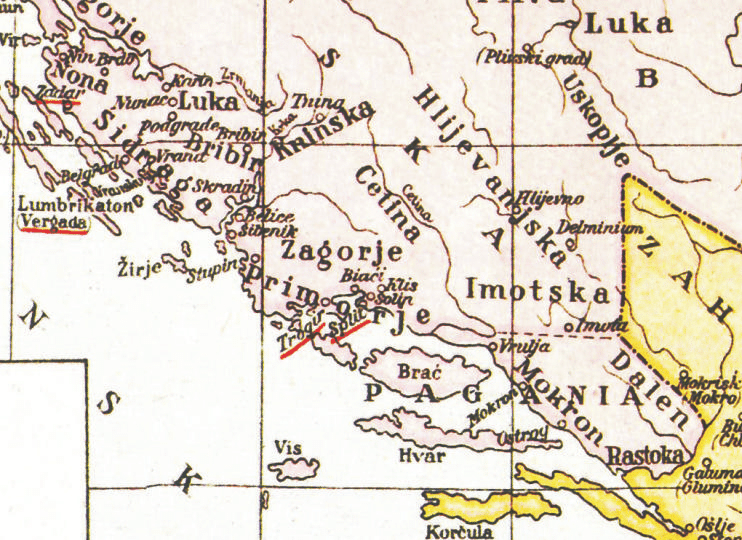
Though the precise date and location of the coronation remain uncertain, Duvno Field has become rooted in the collective memory as the cradle of Croatian kingship. Today, a monument to King Tomislav stands proudly in Tomislavgrad, and commemorative ceremonies continue to honour the enduring spirit of that mythical moment.
As the nation marks the 1100th anniversary of King Tomislav’s coronation, Duvno Field regains its stature as sacred ground – the birthplace of the Croatian crown.
(Sources: https://www.1100-hrvatsko-kraljevstvo.com/kralj-tomislav, Izdvojeno – prof. dr. sc. Mirjana Matijević Sokol, historian, one of the leading experts on the Croatian Middle Ages)
From the series about Croatian rulers: https://youtu.be/yiIgPAB-U1g?si=_p67d2w0zD1G5dv5

